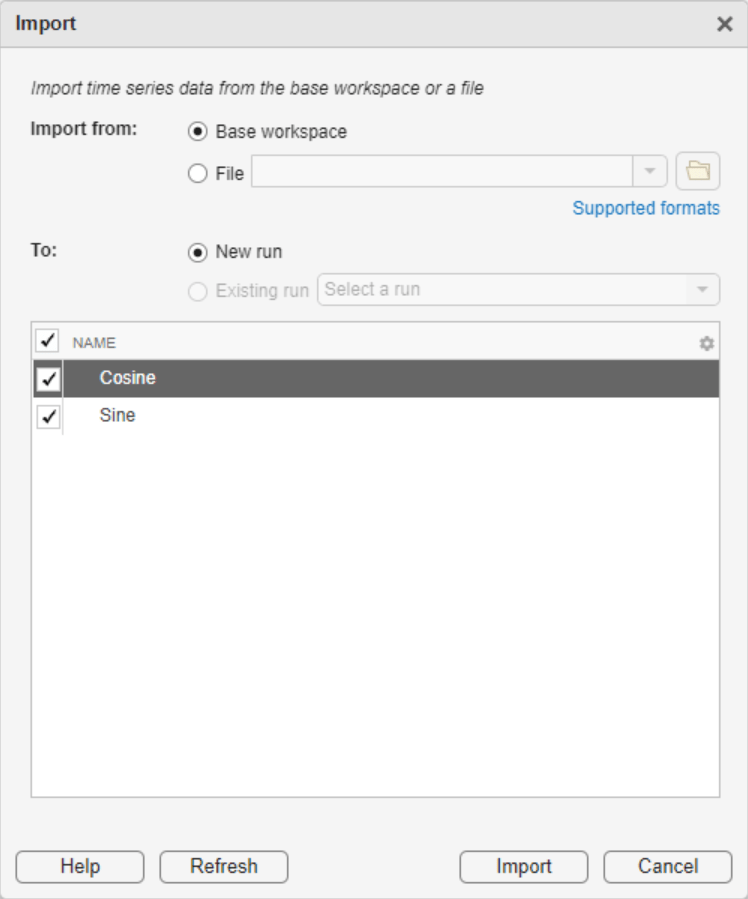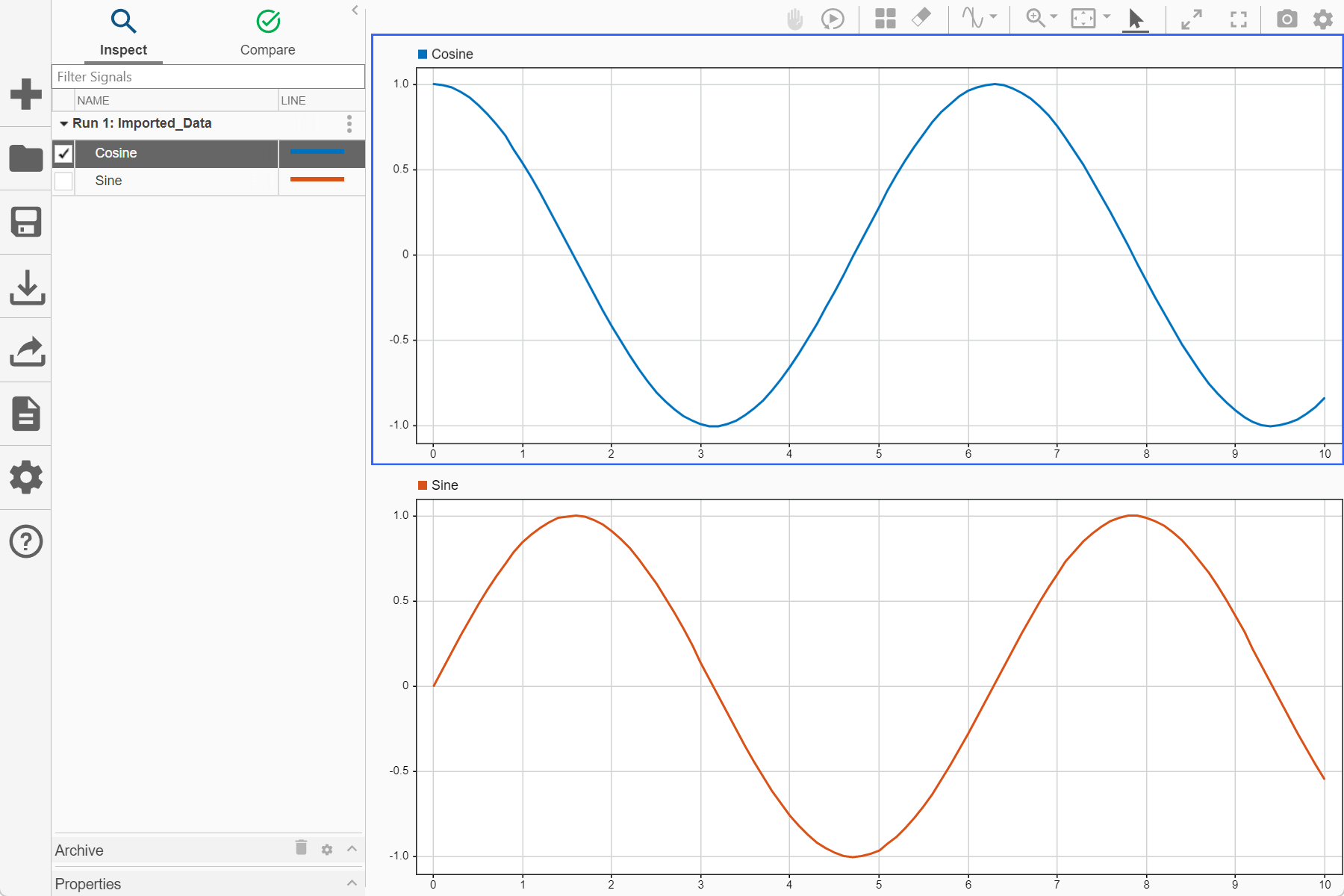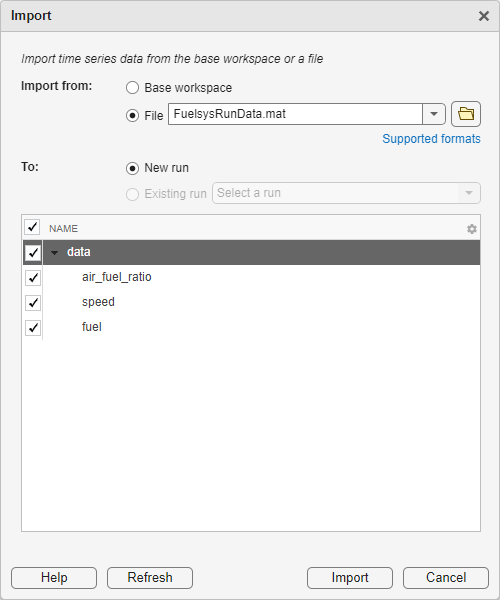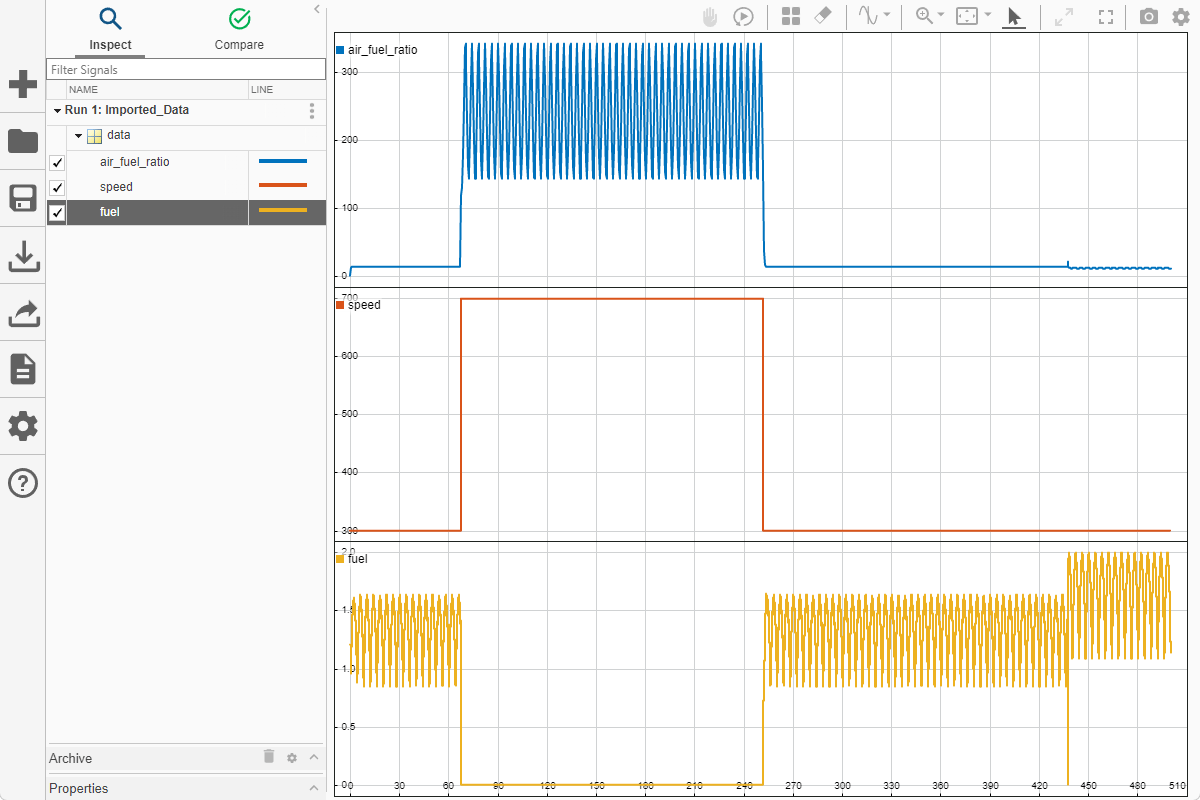将数据从工作区或文件导入仿真数据检查器中
您可以将数据从基础工作区或文件导入仿真数据检查器中。使用仿真数据检查器,您可以单独查看导入的数据或与其他仿真数据一起查看。
仿真数据检查器支持从工作区导入数据的所有内置数据类型和许多数据格式,例如 Dataset、timeseries 和 timetable。无论何种格式,采样值通常都必须与采样时间成对出现。在基于导入的工作区数据创建的一个运行中,仿真数据检查器允许每个信号最多有 8000 个通道。
您可以从许多不同类型的文件导入数据,包括:
MAT 文件
CSV 文件 - 如将 CSV 文件中的数据导入仿真数据检查器中所示的格式化数据。
Microsoft® Excel® 文件 - 如Microsoft Excel 导入、导出和记录格式中所述的格式化数据。
MDF 文件 - Linux® 和 Windows® 操作系统支持 MDF 文件导入。MDF 文件必须具有
.mdf、.mf4或.dat文件扩展名,并且在 MDF 文件通道中仅包含整数、浮点和字符串数据类型。ULG 文件 - 飞行日志数据导入需要 UAV Toolbox 许可证。
ROS Bag 文件 - 支持导入文件版本 1.1 和 2.0 的 ROS Bag 文件。导入 Bag 文件需要 ROS Toolbox 许可证。
要从工作区或以仿真数据检查器不支持的数据或文件格式保存的文件中导入数据,您可以编写自己的工作区数据或文件读取器以使用 io.reader 类导入数据。您还可以编写自定义读取器来代替内置读取器用于支持的文件类型。有关示例,请参阅:
从工作区导入数据
您可以将基于时间的数据从工作区导入仿真数据检查器中。创建包含正弦信号和余弦信号的数据的 timeseries 对象。为每个 timeseries 对象指定一个描述性名称。
time = 0:0.1:10; sinVals = sin(time); cosVals = cos(time); sinTS = timeseries(sinVals,time,"Name","Sine"); cosTS = timeseries(cosVals,time,"Name","Cosine");
打开仿真数据检查器。
Simulink.sdi.view
要以交互方式导入数据,请在仿真数据检查器中,选择导入 ![]() 。在“导入”对话框中,您可以选择从工作区或文件中导入数据。选项下方的表显示可用于导入的数据。如果您在表中没有看到您的工作区变量或文件内容,这意味着仿真数据检查器没有支持该数据的内置或注册的读取器。您可以使用复选框选择要导入的数据,并可以选择是将该数据导入现有运行中还是新运行中。要选中所有数据或不选中任何数据,请使用名称旁边的复选框。
。在“导入”对话框中,您可以选择从工作区或文件中导入数据。选项下方的表显示可用于导入的数据。如果您在表中没有看到您的工作区变量或文件内容,这意味着仿真数据检查器没有支持该数据的内置或注册的读取器。您可以使用复选框选择要导入的数据,并可以选择是将该数据导入现有运行中还是新运行中。要选中所有数据或不选中任何数据,请使用名称旁边的复选框。
在“导入”对话框中:
在从以下源导入下,选择基础工作区。
在到下,选择新运行。
在信号表中,选择
Sine和Cosine信号。点击导入。

当您将数据导入新运行中时,该运行始终显示在工作区中。您可以手动将导入的运行移至存档中。
从信号表中选择信号以在仿真数据检查器中查看数据。要创建两个垂直对齐的子图,请点击“可视化和布局”![]() 。然后,在基本布局下,选择
。然后,在基本布局下,选择 2x1 子图布局。在上部子图中绘制 Cosine 信号,在下部子图中绘制 Sine 信号。

从文件导入数据
MAT 文件 fuelsysRunData 包含来自 sldemo_fuelsys 模型的一次运行的信号数据。有关该模型的详细信息,请参阅容错燃油控制系统建模。
打开仿真数据检查器。
Simulink.sdi.view
要将数据从 fuelsysRunData 文件导入仿真数据检查器中,请点击“导入”![]() 。在“导入”对话框中:
。在“导入”对话框中:
在从以下源导入下,选择文件。然后,键入文件名或导航文件系统以选择
FuelsysRunData文件。在到下,选择新运行。
在信号表中,选中名称旁边的复选框以选中所有信号。
点击导入。

在仿真数据检查器中,使用迷你图可视化来查看数据。点击“可视化和布局”![]() 。然后,在可视化下,选择迷你图。从信号表中选择信号以在迷你图中查看它们。
。然后,在可视化下,选择迷你图。从信号表中选择信号以在迷你图中查看它们。
